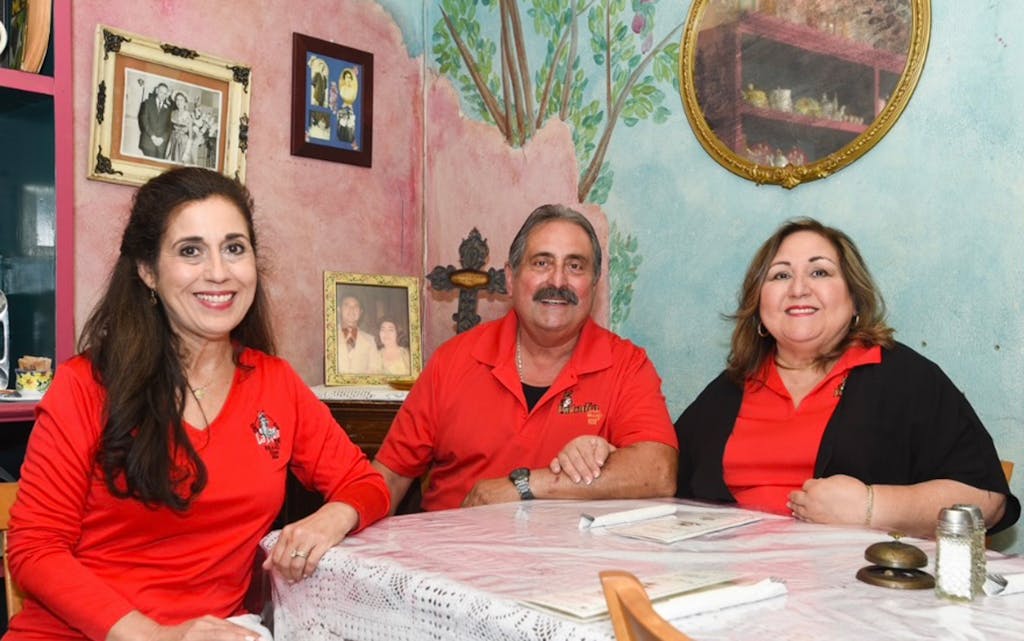Among the culinary mainstays that have made their marks on the palates of Laredoans, few have been more essential than La India Packing Company. This April, the family-owned spice-and-herb company hits a monumental milestone as it turns one hundred years old. An official bash celebrating the anniversary is on the books for April 27, and later this year, the Texas Historical Commission will officially designate the company and its headquarters, in old Laredo, with a historical marker. According to owner Elsa Rodriguez Arguindegui, the reason for the company’s success is simple: “People like the flavors and it doesn’t upset their stomachs.”
It’s that second part, she says, that makes La India stand out. Her grandfather, Antonio Rodriguez, who founded the shop in April 1924, was insistent on combining culinary and medicinal properties to make products that tasted great and wouldn’t wreak havoc on customers’ insides. She says he knew that the chiles and spices Tejanos loved so much can cause acid reflux, which, for some, triggers inflammation, heartburn, and all sorts of regret. With an arsenal of herbs at his side and some expertise passed on from a sacred source, he embarked on a journey to counter those effects. Along the way, he happened to create a spice empire.
Antonio Rodriguez and his wife, Antonia, opened what was first called Antonio R. Rodriguez Abarrotes en General (Antonio R. Rodriguez General Store) next to their home, on the corner of Marcella Avenue and Mier Street. They sold home wares like añil azul, a bleach product, and specialized in traditional Mexican candies, like tricolored pirulís. The history is murky, but between 1924 and 1928 Antonio rebranded the business, ditching the home wares and focusing on herbs and spices instead. A native of Lampazos de Naranjo, Mexico, Antonio frequently traveled to his ancestral home two hours south of the border, where, according to Rodriguez family lore, he visited with an Indigenous Mexican woman who was the town curandera, or medicine woman. Villagers had limited access to medical resources and would visit her to treat their ailments with teas and tinctures made from native herbs and plants.
Rodriguez Arguindegui says her grandfather brought that knowledge back to Laredo, where soldiers who had fought in the Mexican Revolution, which concluded in 1920, had begun asking Antonio to help with their lingering aches and pains from their time in the service. He recommended things like estafiate (mugwort) to settle stomachs, manzanilla (chamomile) to help with stress, and palo azul (Arizona kidneywood) to detox aching bodies—all natural remedies with long traditions among Indigenous tribes across North America. To honor the Indigenous woman of Lampazos, he rechristened the store La India, and he asked his cousin Ofelia Medina to come up with the now-iconic logo to match.
Antonio had tapped the long Mexican tradition of herbal remedies and formalized it, taking it out of the rancho and into the heart of Laredo, where anyone could find relief. From the exotic bark of uña de gato to the everyday bay leaf, whether you needed herbs in a powder, in the raw, or in bulk, La India became a full-service shop for all things natural.
Antonio spent those early days perfecting what would become La India’s signature acid-blocking spice blends. “It was all trial and error,” Rodriguez Arguindegui says. “Quítale, ponle, quítale, ponle”—Antonio went back and forth adding and taking away ingredients until the blend was just perfect. To this day, Rodriguez Arguindegui says, the original menudo and chorizo mixes her grandfather created are the top sellers of La India’s more than three hundred products.
By the time Rodriguez Arguindegui was born, in 1961, the shop had grown to include a neighboring brick building, where the family could sort, pack, and store more product, and an apartment upstairs, where she was raised. The entire operation, with her tías and tíos helping build out and run the business, was a full family affair. She remembers running around with cousins all over the shop, climbing trees around the store while Antonio, who had gone completely blind by his forties, still managed the shop. “He could tell who everyone was just by their footsteps,” she says. “You couldn’t fool him.”
When Antonio and Antonia died, the shop fell to their six children to manage. They had varying levels of interest in the business, but it was her mother, Lupita, who had the means to purchase the company in 1990. She bought the company as a way to honor her husband, Rubén, who died when he was only 48. Rodriguez Arguindegui, who had no experience running a business or ambitions of stewarding the brand herself at the time, says she joined her mother’s journey as a way to fulfill her father’s dream. “This was [my dad’s] love,” she says, “and I guess it became mine. I’m doing it for him.”
Though you can find La India spices in meat markets and a handful of H-E-Bs and Walmarts all across South Texas, there have been many obstacles for the modest operation. A bum deal a couple years ago almost wiped the business out completely. “We’re too big to be small and too small to be big,” Rodriguez Arguindegui says of the struggles that continue to plague the business. A cadre of workers continues to weigh, clean, and pack products by hand. “We can only do what we can do,” she says wistfully, only a hundred-year legacy resting on her shoulders.

That’s not to say Rodriguez Arguindegui doesn’t have a vision for La India’s future. Her dream is of an expanded hacienda-style compound where clients can eat, relax, take cooking classes, and more—a kind of Tejano wellness center. It’s a far cry from the historic headquarters, but small steps in that direction have already been made. In 2000 Rodriguez Arguindegui cleared out space in the storefront to open what she calls the Tasting Room Cafe, a small restaurant where clients and visitors can taste traditional Mexican food made with La India’s spices. It’s open for lunch Monday through Friday, and high-profile judges and lawyers have become lunch regulars for the knockout smoky, homemade mole chicken and the bright yellow and tangy curry tuna salad.
“Did I run out of time?” she asks of her outsized vision of the future for the company. “I don’t know, but that’s my dream.” Rodriguez Arguindegui says none of her children are interested in taking over the business, so the future is hazy. “My mother and I were very naive,” she says, “but here, somehow, we are. By the sheer grace of our creator, we’re still here.”
Natural Selection
To celebrate La India Packing Company’s hundredth year, owner Elsa Rodriguez Arguindegui and a good friend and collaborator, ethnobotanist and homeopathic expert Tony Ramirez, share some functional herbs Tejanos have used for years to ease everyday ailments. As always, check with your doctor before using any kind of treatment.
Estafiate/Mugwort
Abuelas have been using this pungent herb in tea to settle stomachs, treat nausea, and kick-start poor digestion in kids for generations. “This one is a strong herb,” Ramirez says, “so you don’t need to make it too strong.” Steep one to two teaspoons per cup of hot water for five to ten minutes, strain, and drink as a hot tea. Add honey or sugar to combat any bitterness. Note that mugwort is a cousin to ragweed, so if you’re allergic, steer clear.
San Nicolas/Broom Snakeweed
This versatile herb is perhaps best known for its anti-inflammatory properties, making it a great option for arthritis sufferers. It’s prepared the same way as estafiate, but make sure to not boil either when preparing, which will kill the medicinal properties of the delicate stems. “A good rule of thumb,” Ramirez says, “is if the herb is giving off a strong scent, put it straight in a cup, and then pour the hot water over it to let it steep.” Drain and enjoy.
Manzanilla/Chamomile
Almost every culture that has herbal traditions uses this sweet, delicate herb to battle anxiety, stress, and sleep problems, says Ramirez. “It smells like apples,” he says, which is where its Spanish name comes from. Use both the stems and flowers to make a tea through similar preparations to those outlined above.
Uña de Gato/Cat’s Claw
“This is my go-to,” says Rodriguez Arguindegui of this immunity booster. Studies have shown this woody vine to have antioxidant and antimicrobial properties, making it a powerful tool to help the body eliminate free radicals, which can contribute to health problems like heart disease and cancer. Sold as a bark, this sturdy herb can be boiled and steeped for longer to let the water become infused with the active compounds. If you’re anticipating surgery, do not use uña de gato, as it has blood-thinning properties.
Palo Azul/Arizona Kidneywood
Another sturdy bark, palo azul has been used across Mexico since before the Spaniards arrived as a kind of general well-being tonic. A natural diuretic, it is commonly used to flush toxins out of your kidneys and help combat urinary infections. As with uña de gato, research suggests palo azul can also fight disease-causing free radicals in the body. “It has really wonderful benefits,” Ramirez says. Boil and steep up to four pieces of bark for each gallon of water and drink as a hot tea, or just let the bark soak in cold water overnight. The mostly flavorless, mild water should look iridescent once it is infused.
- More About:
- Texas History
- Laredo






